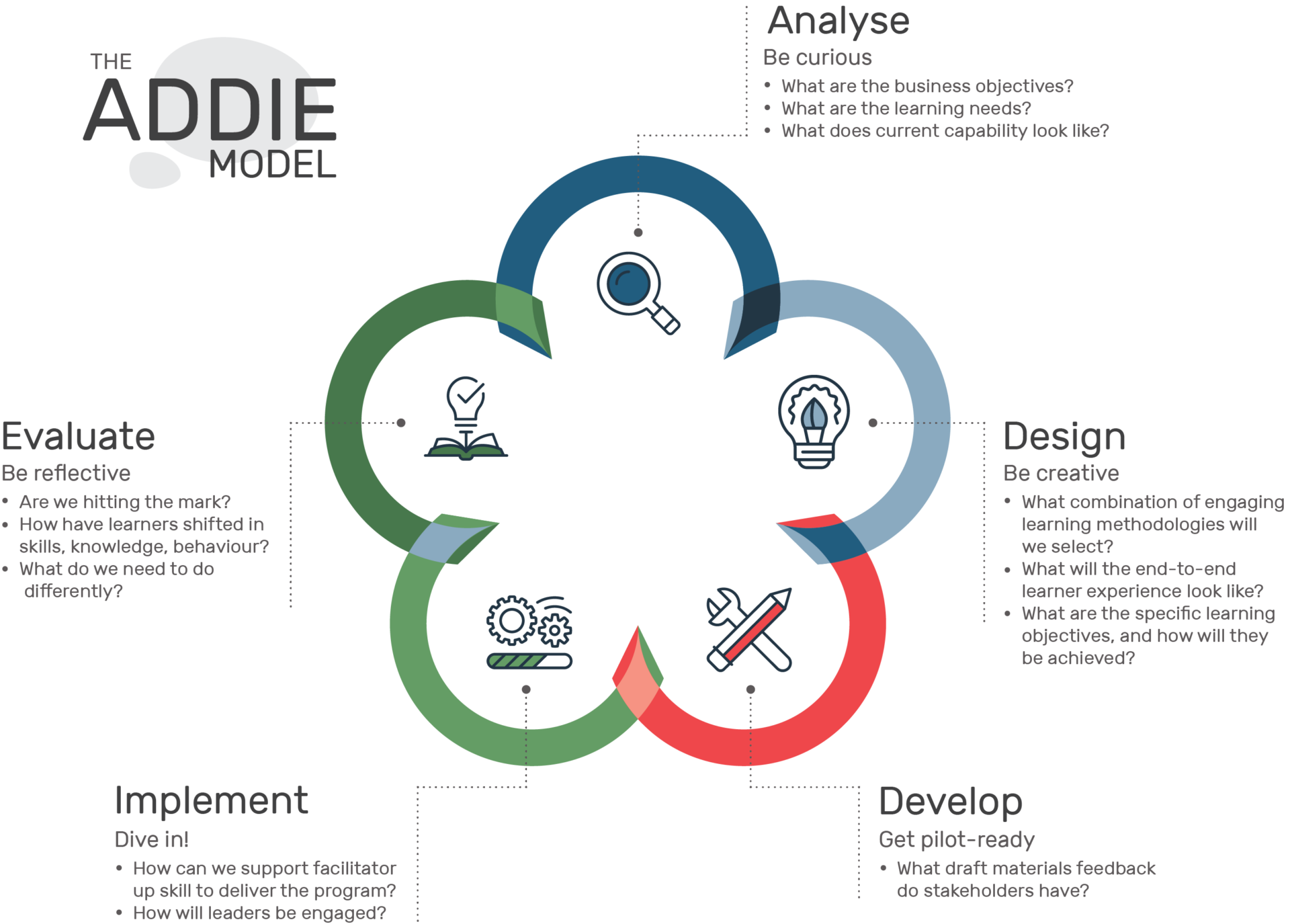What is the ADDIE Model of Instructional Design Anyway?!
What is the ADDIE Model anyway?!
A quick web search about instructional design will undoubtedly reveal many references to the ADDIE model. If you are new to the world of Instructional Design, ADDIE can provide you with a ‘bacon and eggs’ framework to include in your toolkit.
The acronym ADDIE describes an effective approach to the process of instructional design: Assess, Design, Develop, Implement and Evaluate. It is not necessarily linear, and should be used in a dynamic, iterative way for efficient design that identifies critical and relevant learning content.

When was the ADDIE model developed?
The methodology itself was developed in Florida State University’s Center for Educational Technology back in the 1970’s. Initially, the model was created as part of a military training project by the US armed forces. [1]
The idea was to complete each separate phase before moving to the next. Subsequently, practitioners revised the steps, and eventually the model became more fluid and interactive (in a cyclical practice) than the original hierarchical version. By the mid-1980s, the version familiar today emerged [2]. Even though the model is nearly fifty years old, the underpinning methodology has stood the test of time and ADDIE remains a leading learning design methodology to this day.
The model’s popularity is unsurprising, given that it is simple to use, flexible, and requires alignment with business strategy.
ADDIE ensures early engagement with key stakeholders, a clear articulation of skills, knowledge and behaviours that require capability uplift and the creation of a high level learning ‘architecture’ for review – before joining the dots to develop learning materials. It is simple enough for an instructional design novice to apply to an uncomplicated learning need, and robust enough to adapt to a large-scale organisational change project that has many and varied capability shift implications. Key to becoming an expert at applying ADDIE effectively is practicing asking questions and developing a suite of templates to collect analysis and evaluation data, as well as to develop learning materials.
Whilst ADDIE is today considered a cyclical process, debate continues about its relevance and completeness as a model, due to its original application to the US Army. It has received some criticism that it’s neither flexible enough for today’s modern learning environment, nor responsive to the pace of organisational change. Adapting the model to take a cyclical approach enables an instructional designer to iterate and pilot programs of work, allowing for more rapid development and improving the quality of the end product.
From IDA’s perspective though, an adapted version of ADDIE remains relevant and helps to shape effective learning design outcomes. You can watch this video to see how IDA applies the ADDIE model in its work.
Citations
[1]Branson, R. K., Rayner, G. T., Cox, J. L., Furman, J. P., King, F. J., Hannum, W. H. (1975). Interservice procedures for instructional systems development. (5 vols.) (TRADOC Pam 350-30 NAVEDTRA 106A). Ft. Monroe, VA: U.S. Army Training and Doctrine Command, August 1975. (NTIS No. ADA 019 486 through ADA 019 490).
[2]Kurt, S “ADDIE Model: Instructional Design in Educational Technology, August 29, 2017
FAQs
The acronym ADDIE describes an effective approach to the process of instructional design: Assess, Design, Develop, Implement and Evaluate. It is not necessarily linear, and should be used in a dynamic, iterative way for efficient design that identifies critical and relevant learning content.
The five steps of the ADDIE Model are:
- Analyse
- Design
- Develop
- Implement
- Evaluate
The purpose of the ADDIE Model is to provide an effectively structured design method for creating learning programs. Instructional Designers draw on the ADDIE Model to analyse the learning needs, design and develop the solution, implement the solution, and evaluate its success in meeting the learning needs.
The ADDIE Model provides a structured process to create effective learning programs. Each step is vital in ensuring a learning solution efficiently and effectively meets the audience’s learning needs.
is targeted at the audience’s learning needs, and the program is evaluated to maximise its effectiveness in meeting the needs.
The ADDIE Model was developed in Florida State University’s Center for Educational Technology back in the 1970’s. Initially, the model was created as part of a military training project by the US armed forces.
